Teach persuasive writing to SLIFE and Newcomers? When you can’t even understand their writing yet? Yes! We can…and we should!
You can listen to this episode in any podcast app or right here.
If we don’t teach persuasive writing, our ELs will eventually gain enough English to spell better but they won’t have the grade level learning to be successful. You can teach spelling and mechanics but we also need to include ALL students in grade level learning like writing to persuade.
This show is in response to Ms. Locklear who teaches middle grades ESOL in Georgia. THANK YOU, Ms. Locklear for letting me use your question and comments in this show. In this episode, I show how we get to the point where all students are using graphic organizers and outlines like these:
Persuasive Planning Page Organizer
 Loading...
Loading...
Persuasive Outline for rough draft
 Loading...
Loading...
Ms. Locklear has been getting advice to use paragraph frames with her English learners and wonders when we can expect ELs to begin to write independently. She is using paragraph frames and mentor texts, word banks and other supports for her ELs to help them write a persuasive essay.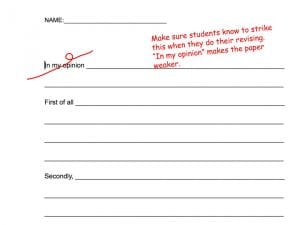
To frame our thinking, I am going to be referring to two different types of newcomers
Newcomers WITH Native Language Literacy (L1)
vs.
Newcomers WITHOUT Literacy in L1
It is so very important to know if your English learner can write in their native language. If they CAN, there is so much we should be allowing them to do in their L1. I mention Translanguaging and Ofelia Garcia when I discuss how students should use all the language they have to think, brainstorm, get their ideas down.
 A big part of my advice has to do with how we teach writing. I’m a certified Abydos writing trainer. As such, I teach educators to see writing as a process. In the book, Boosting Achievement: Reaching Students with Interrupted or Minimal Education, Anna Matis and I include the writing process and what SLIFE students can be doing at each stage. We cite Abydos International and Acts of Teaching II by Joyce Carroll and Edward Wilson.
A big part of my advice has to do with how we teach writing. I’m a certified Abydos writing trainer. As such, I teach educators to see writing as a process. In the book, Boosting Achievement: Reaching Students with Interrupted or Minimal Education, Anna Matis and I include the writing process and what SLIFE students can be doing at each stage. We cite Abydos International and Acts of Teaching II by Joyce Carroll and Edward Wilson.
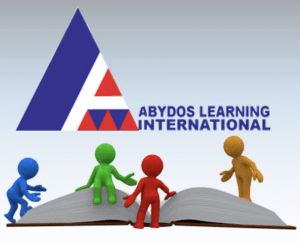
I highly recommend that ELAR teachers attend an Abydos Writing Institute. It is a 3-week commitment but most participants agree that it will change your life! Once you start looking at writing as more of a process, you see that editing is actually the last part of the revising phase.
 Loading...
Loading...
You see… we don’t start with spelling and grammar… we end with that. Real writers, in the real world, are initially just getting their ideas down. Then they revise their writing until they are ready to publish it. It’s just before that publishing phase when we edit to be sure we have everything spelled correctly and that grammar and punctuation is just right so that the reader receives it the way we intend them to. Kids should care about their writing and then they will care about this part.
If you want more specific advice on persuasive writing – taking it a step further to writing argumentative essays, check out this podcast and post by Jennifer Gonzalez. She has a very solid process. And when you’re reading through it, you might imagine how our ELs should be able to take advantage of most of what Jennifer is doing for her students.
In the show, I go over how I teach persuasive writing to ELs and we continue to reflect on the newcomers with L1 literacy and the ones who do not have L1 literacy.
Using Native Language
What is really important to think about is that our students who DO have native language literacy can do their brainstorming and collaborate in their L1 or a combination of L1 & L2. Even our SLIFE students can use their L1 to collaborate with others. This is another reason to have a solid language objective so that we can allow for L1 and not worry about how we are moving their English acquisition.
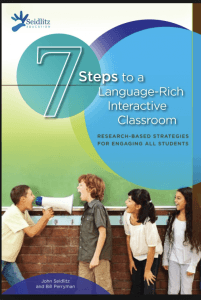 I begin with pre-writing activities and this is one I do throughout the year. The activity is called T-Chart/Pair/Defend. This type of activity can be used in many content areas. In fact, Tina Beene talked about it on my show in Episode 3. She talks about how she shows this to teachers as part of her strategies for teaching ELs in social studies. I love how Tina talks about helping students see multiple perspectives. She has this activity in her social studies book and it is also in our 7 Steps to a Language Rich, Interactive Classroom by John Seidlitz and Bill Perryman. They are the ones who gave us QSSSA as well!
I begin with pre-writing activities and this is one I do throughout the year. The activity is called T-Chart/Pair/Defend. This type of activity can be used in many content areas. In fact, Tina Beene talked about it on my show in Episode 3. She talks about how she shows this to teachers as part of her strategies for teaching ELs in social studies. I love how Tina talks about helping students see multiple perspectives. She has this activity in her social studies book and it is also in our 7 Steps to a Language Rich, Interactive Classroom by John Seidlitz and Bill Perryman. They are the ones who gave us QSSSA as well!
The activity involves having students take a position. You offer a statement like “Students should be able to use cell phones in class.” The students move to one side of the room if they agree, and the other side of the room if they disagree. Once there, we have them collaborate with partners and then groups to come up with their best arguments. When they share out, we ask for complete sentences so the teacher can begin filling out the T-chart. It might look like this: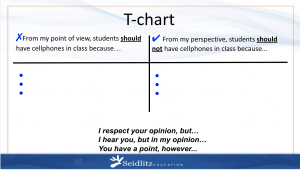
It is crucial that we do these things orally and role play them out so students can internalize how to persuade someone. I want them to connect this to being in a courtroom. Each side of the room is a “lawyer” and I’m the judge. We talk about how our arguments, in written form, can go to an authentic audience like the school board or our principal. But we must first get our best ideas down.
I use QSSSA to support everyone in being part of the discussion, to offer the English to sound scholarly and we also chorally read complete sentences as they are being offered. I am scribing the arguments they give me on the board as a collective brainstorm. Lots of choral reading happens here. We are likely meeting our language objective if it was about producing complete sentences in English or speaking using newly acquired vocabulary.
The next part of this activity is to have students pair up and one person argues one of the points while the other students counter arugues and they go back and forth. They can read from the board or use other arguments. An important piece here is that we teach students how to disagree respectfully. You can see that I have included respectful language on my slide/board for the students to use.
Taking it to Writing
I’m going to model this first writing for the class. I use the T-chart/Brainstorm and show then what it looks like when I write.
There are many reasons to write WITH students so it is important to model writing for the entire class. I take this brainstorm and create a rough draft on chart paper in front of the class so they can hear me think aloud and make decisions about how to include things. They also see that I am not concerned with spelling or grammar at this point. I
We use this T-Chart graphic organizer once we decide which argument we will go with as a class. This is also the graphic organizer I give students to use on their own as we begin to do more and more of these on their own. Again, this is where our students who DO have native language literacy can be using L1 in their pre-writing. Our students who do not have literacy can do this with me or I would do more of this whole group if many students in my class are new to literacy.
 Loading...
Loading...
This video shows how a group of pre-literate newcomers wrote great essays that began formulaic with paragraph frames and scribes to write their words down but the essays were all very personalized by the end of the process. Many of these students won scholarships for these essays.
Paragraph Frames? YES! But we don’t start there…
To answer Ms. Locklear’s question, YES, use paragraph frames but do not start with paragraph frames. Start with helping all students understand what persuasive writing is. Do role-playing like this and look at examples of good persuasive writing. See if they can pick out the claim and how the “lawyer” is convincing you. Have students come up with an opposing view and a counter-argument to all the claims you see so they get used to having those in their paper.
As for your spelling, grammar and mechanics. I would follow the work of Jeff Anderson. Tan Huynh has a great post about Jeff’s approach here. I’ve learned a lot from him about how we should be lifting GOOD sentences and using those in lessons with students. You only need a mentor text to do this. You can use a piece of text you find or you can also use some of the shared writing you have done with your class as your SLIFE students understand those writing pieces.
Using Writing Frames and Structures is a great 10 min podcast by Larry Ferlazzo and some folks in the field who are authorities on writing. They discuss the need for frames and writing structures to help ALL students organize their thinking for different genre.
Here is an example of paragraph frames that would help a student get their ideas down.
 Loading...
Loading...
You might also be interested in Episode 37 of this podcast. I talk about Writing to Learn vs. Learning to Write so I talk alot about content teachers using writing to help students learn their content better. That is very different from learning how to write.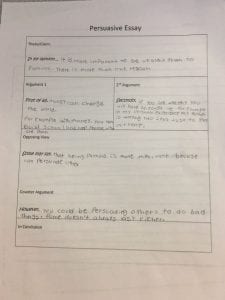
ALSO! If you want more writing support for newcomers, check out this Twitter moment from a recent twitter chat we did on this subject. Our PLN has so many ideas for you!
Next Step: Argumentative Essays
This is all important groundwork for these students who will eventually need to write Argumentative Essays. Those require more evidence and we will soon be in a great position for students to see how they can use evidence to better support their claim. They also need to take personal bias out of the paper and there are other criteria that will help strengthen their papers.
But that will hopefully be another show and if that is your area of expertise, please reach out so I can bring you on the show and we can brainstorm ways to include our English learners.
I hope this has been helpful.
Please reach out if you have questions. I certainly appreciate Ms. Locklear reaching out and letting me gather my thoughts about this for this show.
{{Virtual Hug}}
Carol
PS: Hope to see you soon! Join me at one of these events this year:
Summer 2019
I’m the keynote speaker for #MABEMI19 coming up in May.
Featured Speaker at the Sanibel Leadership Conference in Florida on June 20th
FALL of 2019 – Stay tuned for dates & links:
Coming to Colorado as a featured speaker for COTESOL
I’ll be in Missouri for the MELL Conference in October
I’ll be the keynote speaker for BCTESOL in British Colombia in the fall.
Thank you for sharing! These are great ideas for teaching SLIFE students persuasive writing. However, I would not call it “argumentative” writing unless students also did research and cited specific studies & statistics in their essays. Argumentative writing requires stronger evidence than just personal opinions.
Daria, thank you so much for your important feedback. I have changed the post and the recording to be sure I’m accurately referring to Persuasive Writing vs. Argumentative writing. And I made sure there were links to support that next step where we would begin to cite text evidence together. I’d love to have you come on the show to talk about teaching argument. I know we could brainstorm and share ways to include newcomers and SLIFE in those writing lessons as well.
Thank you again for being part of my learning journey!